Living/Existing with Bears
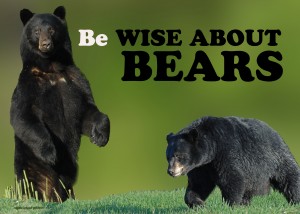 It is a privilege for many to be able to hike, camp or live in an area where there is highly evolved mammals such as the bear. To just as many the very thought of having a bear around evokes fear. Bears only come around people when there is food available. Bears do not consider people food. Bears that are accustomed to being around people and human establishment have not attacked people. The bears get used to the activity of the people in a certain area and therefore appear not to fear harm from the residents. Although it is possible for an individual bear to become assertive when accessing peoples food in garbage or bird feeders there is no record of an all out attack from a bear behaving in this way. Many times a bear’s assertiveness is misread as aggression and the bear is killed. When a bear clacks it teeth, exhales heavily through its nose, slaps the ground with its paws, the bear is “asking” the person to leave or give it more space. Rarely does this kind of behavior from a bear result in a injury to a human. Most people do not want to see bears up close or near their home. DO NOT encourage them with poor food disposal habits or by leaving bird feeders out after the grass turns green in the spring.- Mike McIntosh
It is a privilege for many to be able to hike, camp or live in an area where there is highly evolved mammals such as the bear. To just as many the very thought of having a bear around evokes fear. Bears only come around people when there is food available. Bears do not consider people food. Bears that are accustomed to being around people and human establishment have not attacked people. The bears get used to the activity of the people in a certain area and therefore appear not to fear harm from the residents. Although it is possible for an individual bear to become assertive when accessing peoples food in garbage or bird feeders there is no record of an all out attack from a bear behaving in this way. Many times a bear’s assertiveness is misread as aggression and the bear is killed. When a bear clacks it teeth, exhales heavily through its nose, slaps the ground with its paws, the bear is “asking” the person to leave or give it more space. Rarely does this kind of behavior from a bear result in a injury to a human. Most people do not want to see bears up close or near their home. DO NOT encourage them with poor food disposal habits or by leaving bird feeders out after the grass turns green in the spring.- Mike McIntosh
“In working closely with wild bears for the past 40 years, I have gradually become more and more comfortable with them as I learned their “language” and how they think. I have learned to trust certain bears and bear families to the extent that they mostly ignore me as I walk and sleep with them for up to 24 hours at a time.” Dr. Lynn Rogers~
The following statement is by Jim Johnston of Elliott Lake Ontario, Canada.
“As in all things, education is the key! I know that from experience”.
I held all the long term erroneous beliefs about Black Bears portrayed by the media until I learned from the world’s leading bear experts including Dr. Lynn Rogers about the ‘true nature of bears’. My wife and I have attended 3 field sessions at his research facility outside Ely Minnesota at the Wildlife Research Center. He has worked in bear research for over 47 years. I also depend on other bear experts from MNR as well as Dr. Joe Hamr of Cambrian College in Sudbury who helped us design our Elliot Lake Bear Wise program. I also keep in touch with Dr. Steve Hererro (Prof. Emeritus from U of Calgary), who has also studied bears for over 45 years & wrote the book on Bear Attacks Their Causes & Avoidance as well as Sylvia Dolson who was a founding member of the JJ Whistler Society that started the Bear Smart programs used extensively in many Western towns to reduce nuisance bear problems.
What is needed to reduce bear problems in communities is implementation & enforcement of Bear Wise protocols. It only works if you do it!” (Link to Bear Wise: http://www.mnr.gov.on.ca/en/Business/Bearwise/) – Jim Johnston of Elliott Lake Ontario, Canada.
Interactions with Humans
Interactions between humans and black bears are most likely to occur near what a bear 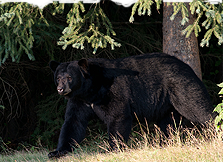 identifies as a food source. The frequency of such encounters depends on a number of factors:
identifies as a food source. The frequency of such encounters depends on a number of factors:
• how much natural food is currently available to bears
• how much natural food was available to bears in the previous summer and fall
• the proportion of the bear population that consists of yearling and two-year-old bears (which will peak one or two years following highly successful reproductive years). Yearlings and two-year-olds wander widely as they disperse from the area where they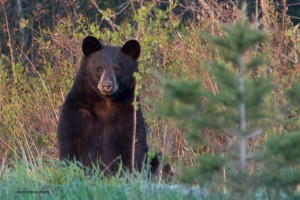 were born. They are often unwary and naive and are more likely to come into contact with humans.
were born. They are often unwary and naive and are more likely to come into contact with humans.
• whether bears have ready access to human garbage
• availability of agricultural and horticultural crops
• seasonal human behaviour that brings people into contact with bears
(e.g. encounters will increase when people begin to arrive at cottages and campgrounds).
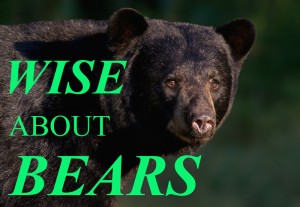 In the majority of situations, black bears pose no threat to humans, but there are several factors that may affect perceived or real dangers in those situations
In the majority of situations, black bears pose no threat to humans, but there are several factors that may affect perceived or real dangers in those situations
At dumps: Many people encounter bears at local dumps or landfills where bears congregate around the high energy food source. In such situations, bears have well developed dominance hierarchies and have few aggressive encounters among themselves other than noisy displays. Bears at dumps seldom pose any threat to humans unless people attempt to feed bears by hand, or approach too closely while trying to photograph animals.
Along Roadsides: Bears encountered along roadsides may quickly become ‘panhandlers’ if they are fed by passing motorists. In these cases the bears may lose their fear of humans, and people have been bitten or scratched while attempting to feed panhandling bears.
Wilderness situations: People may also encounter bears along trails or in other wilderness situations, but close encounters are most likely to occur near potential food sources.
When a Bear Becomes a Nuisance
Not all black bears encountered by humans are nuisances. We consider a nuisance bear to be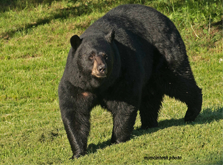
one that poses an immediate threat to human safety or one that has developed a pattern of behaviour that makes it a long term risk to safety or property. In all situations where bears are perceived as a nuisance, the objectives should be to first eliminate risks to human safety and then to minimize the risks to the animal(s). The following section is intended to assist in the decision making process and in the development of response plans.
Responses to Nuisance Bears
Some nuisance bear complaints require direct action and some do not.
No Action Required
Complaints that do not require direct intervention generally include simple sightings, and reports of bears raiding garbage, bird feeders, compost, barbecues, and livestock forage. Inthese cases, always review the situation, ensure there is no danger to humans, caution the complainant to avoid contact with the animal, and provide advice on how to avoid recurrence of the problem. Taking no direct action is a viable option for some nuisance bear complaints, particularly those that are simply reported sightings or that are related to a specific attractant (e.g. garbage) in a specific location.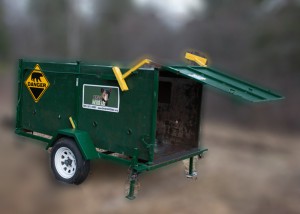 In such cases personnel should be prepared to provide an assessment of the situation and to put forward suggestions to assist in remedying the problem. Once an attractant is removed, bears will generally return a couple of times searching for
In such cases personnel should be prepared to provide an assessment of the situation and to put forward suggestions to assist in remedying the problem. Once an attractant is removed, bears will generally return a couple of times searching for
food and will then likely exclude the area from their foraging excursions. Municipalities, businesses, and rural inhabitants that use bear-proof garbage bins will greatly reduce the number of nuisance bear problems, as will urban inhabitants who keep their garbage indoors until scheduled garbage collection.
Questions & Answers regarding behaviour and human/bear coexistence.
Video

